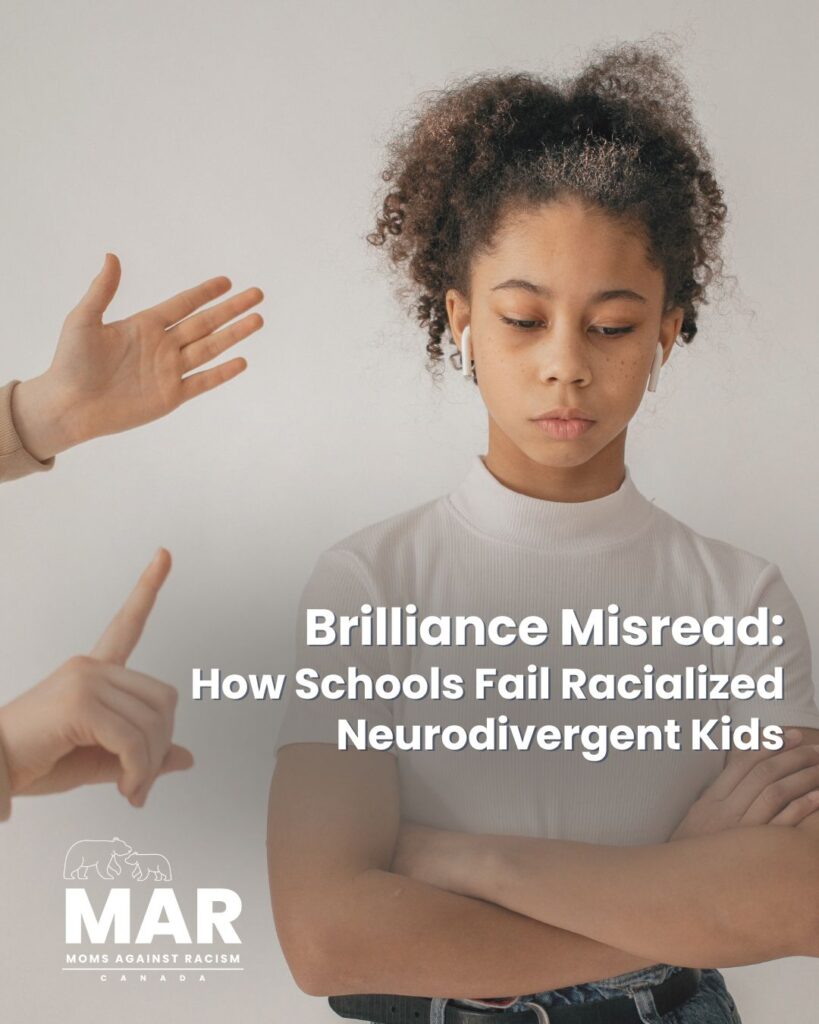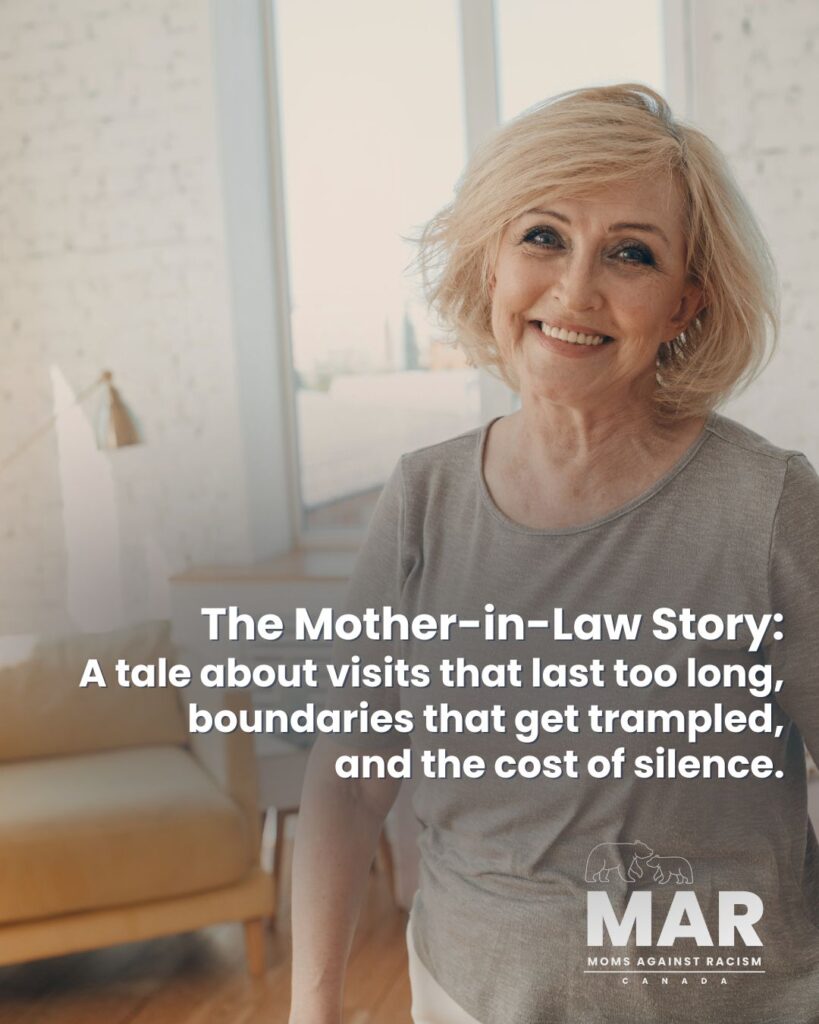Brilliance Misread: How Schools Fail Racialized Neurodivergent Kids


In classrooms across Canada, children bring with them not only their racial and cultural identities, but also the unique ways their brains are wired. When those identities intersect, when a child is both racialized and neurodivergent, the school system often drops the ball. Instead of being seen and supported, these children are too often overlooked, misjudged, or punished.
This is not an abstract issue happening in theory. It is the lived reality of so many racialized kids who are ADHD, Autistic, have anxiety or a learning disability, or one of the many other ways to be neurodivergent.
To understand the cost, let’s walk with Aisha.
In Grade 1, Aisha loved stories. She would sit for hours at home flipping through picture books, creating new adventures for the characters. She asked endless questions, sometimes rapid-fire, her curiosity bubbling over. At school, though, her energy didn’t always land well. She blurted out answers before raising her hand, lost her place in worksheets, and often got in trouble for “talking too much”.
Her teacher described her as “bright but scattered”. Report cards said she needed to “work on self-control”. Her parents wondered why their daughter, who could talk about planets and design elaborate Lego cities, couldn’t seem to finish simple assignments.
By Grade 3, the gap widened. Math tests left her frozen. The ticking of the clock, the rustle of papers, the buzzing of fluorescent lights, it all piled up until her brain shut down. Instead of asking for help, she doodled on the margins of the test, her way of coping. The teacher circled her blank answers in red and wrote, “Needs to focus”.
At recess, things weren’t easier. Aisha longed to play but often misread social cues. When friends teased, she took it literally and withdrew. When she became overwhelmed, she snapped, yelling or storming off. Soon she was known as “the dramatic one”.
Her parents started to wonder if she might have ADHD or be on the autism spectrum. They asked the school for support. The response? “She’s fine, really. You’re probably worrying more than you need to. Lots of kids like her at this age can be a little overly energetic and easily distractible. If it helps you feel reassured, we could put her on the list for an assessment, though she likely won’t be seen until Grade 5 anyway. Honestly, what she probably needs most is a bit more consistency and discipline at home. Children from different backgrounds sometimes just need stronger routines. No need to make this into a bigger issue than it is, we can just monitor how she’s doing for now”.
But waiting and “monitoring” meant years of frustration.
The Turning Point
By middle school, Aisha’s struggles had intensified. She masked her confusion in class by pretending not to care. She avoided group work, terrified of being called “bossy” or “weird”. When she melted down by crying, shouting, and shutting down, she was sent to the office.
Without understanding or even acknowledging Aisha’s neurodivergence, the school began to view her as a problem. In a system already biased against Black and Indigenous students (and families) to expect lowered abilities and increased behavioural challenges, Aisha’s behaviors were interpreted through a racialized lens. Where a white peer might be described as “quirky,” Aisha was “rude”. Where another child might be given extra time, Aisha was disciplined for “procrastinating” or “refusing” to complete the task.
When Aisha tapped her pencil, it was a regulation strategy, not defiance.
When she froze during tests, it was sensory overload, not laziness.
When she spoke directly, it reflected her literal processing, not disrespect.
Her self-esteem eroded. At home, she cried after school whispering, “Why am I like this? Why can’t I just be normal? Why does no one understand me? Why am I always in trouble?”
The school said it was because she was disruptive, unfocused, and not trying hard enough, but what was really happening was a collision of race and neurodivergence within an institution still steeped in racism and ableism.
Finally, after relentless advocacy and gaining a reputation as “That Parent”, her parents secured a private assessment outside the school (at a cost of approximately $4,000 out of pocket). The results were clear: ADHD combined type, autism spectrum disorder, and anxiety.
The diagnosis didn’t change Aisha overnight, but it did give her and her family language, knowledge, and validation. It explained the years of struggle. It shifted the story from “Aisha is broken” to “Aisha’s brain works differently and, in a neuro-normative environment, she needs support”.
Why This Story Matters
Clinically, what happened to Aisha is not rare. Black and Indigenous children are diagnosed with autism years later than white peers. ADHD in racialized youth is often mislabeled as behavioral problems. Emotional dysregulation is treated as defiance, not as a signal of distress.
By the time many finally receive an accurate diagnosis, the damage is done:
- Internalized shame and low self-worth.
- Academic disengagement or failure.
- Higher rates of anxiety, depression, and trauma.
- Greater likelihood of school suspension or dropout.
The tragedy is that with earlier recognition, Aisha’s story could have been vastly different. Early diagnosis means early support. It means interventions tailored to her learning style. It means teachers seeing her meltdowns as signs of overwhelm, not misbehavior. It means affirming her strengths, creativity, curiosity, big-picture thinking, rather than punishing her differences.
Beyond Aisha: A Call to Action
Aisha’s story is not just her own. It echoes through classrooms everywhere. Every child like her carries brilliance waiting to be nurtured, yet too often faces misunderstanding and harm.
The clinical research is clear that diagnosis matters. Not for labels, but for understanding. Not to pathologize, but to unlock support. Not for special privileges, but for equity. When done with cultural humility, accurate diagnosis becomes liberation: a pathway to belonging, identity, and opportunity.
Educators, schools, governments, clinicians, and communities must:
1) Educators
- Recognize ADHD and autism beyond narrow stereotypes rooted in white, middle- to upper-class boys.
- Shift from deficit-based language to neuro-affirming language that values differences as part of human diversity.
- Replace punitive discipline with restorative, supportive approaches that prioritize safety, regulation, and belonging.
- Design classrooms where flexibility (movement, sensory supports, alternative communication) is the norm, not the exception.
- Engage in ongoing anti-racism, anti-ableism, and neuro-affirming professional development.
2) Parents Within the School Community
- Believe and support racialized parents when they raise concerns about their child.
- Challenge stigma by speaking up when you hear harmful stereotypes about neurodivergence or racialized students.
- Partner with schools to build more inclusive environments for all children, not just your own.
- Model acceptance of neurodivergent children to your own kids. Teach them that difference is not deficiency.
3) Schools & Government
- Embed the social model of disability into policies: identify and remove barriers in environments, practices, and attitudes.
- Ensure all assessments and supports are culturally responsive, linguistically accessible, and trauma-informed.
- Shorten assessment wait times by increasing public funding for accessible evaluations.
- Provide equitable access to resources like educational assistants, sensory-friendly spaces, and diverse learning pathways.
- Mandate anti-racism, anti-ableism, and neuro-affirming training for educators, clinicians, and policymakers.
- Collect and publish disaggregated data on race and disability to identify inequities and ensure accountability.
- Invest in community-led, culturally grounded neurodivergence programs and services.
4) Parents of ND BIPOC Kids
- Trust your observations of your child. Your perspective matters, even when schools dismiss it.
- Document concerns and communications with schools to build a record that cannot be ignored.
- Seek out community networks of other racialized ND families for mutual support and advocacy.
- Teach your child that their neurodivergence is not a flaw but part of their brilliance and identity.
- Advocate collectively whenever possible. Systemic change is harder to ignore when voices are raised together.
- Become a member of MAR and join our virtual groups: Neurodivergent Caregivers and Families Circle and/or BIPOC Caregivers Circle.
Aisha deserved better. Every child like her deserves better.
When schools fail to acknowledge and support neurodivergence in racialized youth, they restrict academic success, deny dignity, and derail positive identity development. But when we recognize, support, and affirm neurodivergent racialized children early, when we choose to see the whole child, we give them the chance to thrive. Every child deserves to walk into a classroom and know: I am understood. I am supported. I belong.
October holds space for both National ADHD Awareness Month and Invisible Disabilities Week (October 19–25). These are reminders that so many children, youth, and families are carrying experiences that are unseen, misread, or denied. For racialized neurodivergent kids, those barriers are even heavier as they are layered with racism, ableism, and a school system that too often refuses to see their brilliance.
This blog was created in collaboration with our project partner, InFocus Counselling, whose Autistic and neurodivergent clinicians bring lived experience and deep compassion to their work. Through their ADHD Diagnostic Clinic and autism assessments, they provide trauma-informed care that honours dignity, pace, and story. Their work shows what is possible when neurodivergence is not treated as a problem to fix, but as an identity to affirm.
#NeurodiversityInEducation #BIPOCAndNeurodivergent #BlackAndAutistic #IndigenousAndNeurodivergent #DisabilityJustice #EndAbleism #AntiRacistEducation #IntersectionalDisability #ADHDAwarenessMonth #InvisibleDisabilitiesWeek #EquityInEducation #NeuroAffirming #StopSchoolExclusion #SocialModelOfDisability #NeurodivergentKids #Intersectionality #NeurodivergenceAndRace #RacialJusticeInSchools #MomsAgainstRacism






Responses